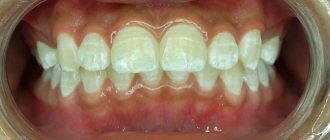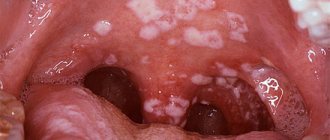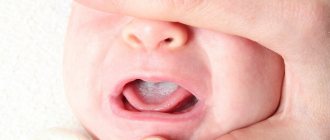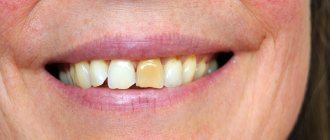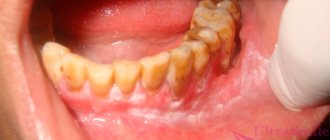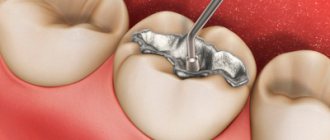Causes of white spots on teeth
Pigment spots can be small, glossy, barely noticeable. If you ignore them, they enlarge and become dull and porous. There are several reasons for their appearance.
Carious lesions
Changes in tone first appear in the gingival area. A whitish tint can appear on one tooth or on several at once. Over time, the surface becomes thinner, the healthy shine disappears, and roughness is noticeable. The enamel becomes thin and vulnerable, the process of destruction begins, and dark spots appear on the teeth.
Hypoplasia
Underdevelopment of enamel due to congenital pathologies. During pregnancy, the mother suffered from infectious diseases, had serious toxicosis, or other disorders were recorded.
Fluorosis
Oversaturation of the body with fluoride. Characteristic of some regions with a special water composition. May be a consequence of improper intake of dietary supplements. In this case, the first marks appear on the frontal teeth and spread to the remaining units. After some time, the shade changes - now brown spots are visible on the teeth.
Long-term mechanical impacts
For example, when wearing braces and other orthopedic structures for a long time, weak enamel wears away. A white spot appears on the tooth.
Injury
Upon impact, a microcrack appears, which is difficult to see. Or the patient does not consider a scratch that does not cause inconvenience to be a serious defect. But the integrity of the enamel is damaged, bacteria destroy the tissue, and a dark stain appears on the teeth.
Insufficient hygiene
Dental plaque accumulates in the interdental spaces, in hard-to-reach areas, and the destructive process begins.
White spots on the skin of children – vitiligo, pityriasis alba
Authors : Christophe HSU, Global Dermatology Information Portal
Typical causes of white spots on the skin of children are: 1) Pityriasis alba 2) Vitiligo
What is “Pityriasis alba”?
- Pityriasis alba is a mild form of dermatitis (skin inflammation).
- This condition is characterized by the appearance of numerous oval, slightly scaly, smooth, hypopigmented (white) patches on the face, arms, and upper torso.
- The boundaries of these spots are unclear.
- The disease occurs in children aged 3 to 16 years; about 30% of children at this age may be susceptible to this disease.
- The spots are not accompanied by itching.
- This disease is often mistaken for a fungal infection (mycosis).
- The condition tends to worsen with exposure to sunlight.
Treatment of pityriasis alba and preventive measures
- This disease is safe. It occurs in cases of hereditary predisposition or against the background of atopic dermatitis. The treatment essentially involves moisturizing the skin.
- The disease can last from several months to several years with a slow spontaneous recovery process.
- Sometimes steroid creams can improve the condition.
- Do not self-medicate.
- Avoid using antifungal creams.
- Limit the use of soap when washing your skin and use detergents that do not contain irritants.
What is vitiligo?
- Vitiligo is the loss of skin pigmentation in certain areas of the skin. These areas of skin appear as smooth white spots with clear contours. The hair in the area of vitiligo spots is often also white.
- There are two types of vitiligo:
- Type A: Vitiligo appears as numerous white patches, widespread and symmetrical. This type of vitiligo most often affects areas of the body such as the limbs, face and neck.
- Type B: Vitiligo appears as localized patches of segmental distribution. This type of vitiligo is most common among children.
- Vitiligo type A tends to spread to other areas of the skin, forming new lesions over time.
- Vitiligo type B tends to spread rapidly and then stop progressing after about one year.
- The causes of vitiligo are not fully known. Among people suffering from vitiligo, the most common cases are diabetes mellitus and thyroid disease.
How is vitiligo treated?
- Your doctor may prescribe one or more of the treatments listed below:
- Topical steroid creams. This method may promote skin repigmentation in some patients.
- PUVA (psoralen + ultraviolet A) is a combination treatment that involves using the drug Psoralen (P) and then exposing the skin to ultraviolet A (UVA). Psoralen can be applied to the skin as a lotion or taken orally in tablet form to increase the skin's sensitivity to ultraviolet rays. Patients undergoing PUVA treatment should be aware that the duration of therapy may be more than a year to achieve optimal results. It is best if this treatment is carried out under the supervision of a dermatologist.
- Concealing cosmetics. Using some cosmetics, you can choose a color that most closely matches your natural skin color. Concealing cosmetics are found to be effective in covering up white spots on the face and back of the hands.
- Sunscreens. Areas of skin affected by vitiligo are prone to sunburn. It is recommended to use sunscreen on affected areas exposed to sunlight.
- Response to treatment may vary across different affected areas of the skin and may vary between patients.
Source
The appearance of spots in children
White spots on a child’s teeth often develop due to hypoplasia or reduced immunity. A weakened body becomes vulnerable, the enamel becomes thinner, and the demineralization process starts quickly. Spots appear on the surface of the teeth - bacteria begin to destroy the tissue structure, these are manifestations of caries in the initial stage.
If a child is undergoing orthodontic treatment, then you should follow the doctor’s recommendations and not ignore in-office cleaning of the structures. Braces make it difficult to physiologically clean the surface of the teeth with saliva; the enamel dries out and its shade changes, becoming brown.
Children in their early teens are three times more likely to develop fluorosis than adults. The reason is clear - during this period there is an active change of teeth, tooth enamel is formed. Therefore, doctors focus the attention of adults: the maximum daily dose of fluoride for children is 3 mg.
Light or yellow spots on the teeth appear when the pH of saliva changes - this is a consequence of poor nutrition (for example, eating a lot of sweets).
Fragility of units and the presence of yellow spots in children and adolescents often indicate a lack of minerals. The reason is a weakened state after illness or poor nutrition. The menu for children and teenagers should include foods containing phosphorus, potassium, calcium, and other minerals. You can use high-quality dietary supplements recommended by your dentist.
3.Diagnosis and treatment of the disease
Since the signs of the disease are obvious, incl. and for the patient himself, diagnosis is not difficult. Otherwise, the patient’s well-being does not change in any way. The problem here is seen, first of all, as cosmetic: spots appear, let us remind you, mainly on open areas of the body. There is no cure for vitiligo. Medical care options are limited to reducing the rate of skin depigmentation and expansion of spots.
An integrated approach to solving this problem is necessary, especially if the first signs of the disease arose as a result of specific, well-known provocations. In some cases, vitamins or microelements are prescribed, in others medications are needed to maintain the nervous system; Photochemotherapy, photosensitizing drugs that stimulate melanin production, and ultraviolet irradiation are also used.
The disease itself sometimes leads to psycho-emotional stress due to the patient’s neurotic fixation on the visible manifestations of the disease. Sometimes the patient even needs psychological help or training in auto-training techniques to prevent the disease from “cycling” into an avalanche-like chain reaction, where vitiligo provokes itself to further development. Sometimes a person is so depressed by changes in his appearance that he insists on transplanting patches of pigmented skin onto visible discolored areas; A tattooing method is also practiced, in which light spots are tinted with a pigment of a suitable color.
Skin depigmentation is a disease known since ancient times, and various peoples use numerous methods to restore skin color. For example, in a number of African countries, dehydration and a strict diet are practiced, sometimes leading to dangerous exhaustion. There are cases when such “treatment” turned out to be effective. Perhaps this is a consequence of the action of purely psychological, autosuggestive regulatory mechanisms, but it seems more likely that under conditions of severe restriction in food and water, parasites die
, living in the body and causing skin depigmentation;
however, the disease can be caused by completely different reasons. Other cultures have developed less radical “folk” ways
to slow down depigmentation and restore skin color: ointments, insolation, decoctions and infusions of herbs for oral and external use.
About our clinic Chistye Prudy metro station Medintercom page!
Why good oral hygiene is important
You need to brush your teeth twice a day with a properly selected toothpaste and brush, and floss after each meal. Why do white spots appear on teeth even when hygiene rules are followed?
Sometimes the cause of thinning enamel is the constant use of highly abrasive toothpastes. There are patients who try to use “grandmother’s” cleaning recipes, not taking into account their traumatic nature for the enamel. In this case, the hygienic procedure will only speed up the transformation of a small spot on the tooth into a full-fledged carious area.
Using a standard toothbrush on your own cannot remove all microparticles of food or remove pathogenic microflora. Therefore, regular professional cleaning using special equipment in the clinic is necessary.
2. Causes of the disease
People with light spots on their skin usually do not feel sick. However, it has been noted that certain autoimmune diseases increase the likelihood of vitiligo. It has also been noted that workers in some chemical industries are susceptible to similar skin pigmentation disorders, which indicates a connection between depigmentation and the influence of external factors. There is no clear answer to the question of the causes and mechanisms of skin pigmentation disorders. There are a number of factors that most often provoke the development of depigmentation:
- stress conditions and mental trauma;
- severe physical injuries;
- neuroendocrine disorders;
- infectious diseases;
- parasites;
- states of severe intoxication;
- liver diseases;
- violation of the exchange of micro- and macroelements.
Visit our Dermatology page
Diagnostics
During the first visit, the doctor will conduct an examination and, if necessary, prescribe additional studies to clarify the cause of the appearance of white or dark spots on the molars and baby teeth.
- If spots are noticed in a child, then information about the course of pregnancy is collected - hypoplasia should be excluded.
- Drying the tooth surface allows you to detect the onset of caries. After drying, the enamel on the damaged area becomes matte. The use of magnifying microscopes makes it possible to detect minor damage - cracks, scratches.
X-rays or a tomogram may be ordered.
Features of children's skin
At birth, babies have very thin skin. The skin of a newborn is almost half as thick as the skin of an adult. The outer layer thickens with age.
The skin of newborns is red or purple in color due to the close proximity to the upper layer of blood vessels and an insufficient layer of subcutaneous cellular tissue, as a result, the skin appears “transparent”. This phenomenon is especially pronounced if the baby is frozen - the appearance of a marbled vascular network on the body is observed.
Moisture evaporates faster from the skin of newborns. Children are more susceptible to bacteria, viruses, fungi and mechanical influences. Thickening of the skin begins at 2-3 years of age and ends by 7 years.
Treatment
The process of eliminating a defect depends on the true cause of its manifestation. Therefore, there is no single recipe: the dentist proceeds from the individual characteristics of the patient and the degree of enamel damage. If the reason:
- When caries begins, a conservative approach is popular. Remineralization is necessary: saturation of the enamel with minerals using special ionizers, the use of physiotherapy (for example, exposure to ultrasound in parallel with the application of therapeutic compresses to the teeth). It is possible to apply a special preparation that closes the pores on the enamel and restores its smoothness and hardness. If the condition worsens, therapeutic treatment and installation of a modern filling are required.
- Hypoplasia. Silvering of teeth and also saturation with minerals and fluoridation are practiced. Dietary supplements containing calcium, phosphorus, and zinc are prescribed. If the application was late, then after adulthood, veneers or crowns can be used for camouflage.
- Fluorosis. Removing stains requires the use of special applications; electrophoresis is prescribed. It is necessary to drink only filtered, purified water and do not use fluoride-containing pastes. If part of the tooth is already destroyed, a filling is necessary.
- A consequence of wearing orthodontic structures (usually braces). When light spots are visible, procedures for local remineralization are applied. Toothpastes with fluoride are prescribed.
When white or already black spots on the teeth are a delayed consequence of an injury, then, depending on the nature of the damage, the doctor will prescribe conservative restoration (local remineralization, medication) or a radical intervention with reconstruction, splinting, or prosthetics will be required.
Pyoderma in a child
If you take your baby's hygiene seriously, you can prevent many health problems. This also applies to skin pathologies - dermatitis, which has numerous varieties. The most common form of dermatitis in childhood (especially in the first months of life) is pyoderma.
Pyoderma is a purulent skin disease, which is a group of pathologies that develop against the background of penetration of pyogenic microorganisms into the skin. Parents should take into account the ways of transmission of pyoderma: germs are transmitted when the child comes into contact with sick people or a contaminated object.
The disease is most often diagnosed in childhood and has many types. There is an opinion that the cause of pyoderma lies in poor diet and poor hygiene. Although this is not entirely true. This skin pathology develops under the influence of various pathogens: streptococci, staphylococci, pneumococci, Pseudomonas aeruginosa, E. coli, etc.
Often the human body is the habitat of certain microorganisms, which are activated when protective functions are reduced, which leads to the appearance of their pathogenic qualities.
Since the protective function of newborns and infants is more weakened, pyoderma in such patients occurs in a severe form. This happens if treatment is not started in a timely manner and the baby is not properly cared for. In the body of children under 2 months of age, there is no independent production of antibodies. As a result, it is important to care for the baby’s skin throughout the body.
Prevention
Preventive measures will help strengthen the surface of the teeth and prevent the appearance of black spots on the enamel. What you can do:
- Brushing your teeth regularly, the type of toothpaste and type of brush should be discussed with your doctor.
- Visit the dentist twice a year for preventive purposes.
- Create the right diet: include foods containing minerals and substances necessary to maintain dental health. These are dairy products, vegetables and fruits (a differentiated approach is necessary, since in some cases the approach to the acids they contain is selective), eggs, lean meat, fish and other products.
It is worth paying attention to additional measures to maintain immunity: do not forget about moderate physical activity, take vitamin and mineral complexes, get vaccinations in a timely manner (especially for children).
Author: Zhukov M.A.

